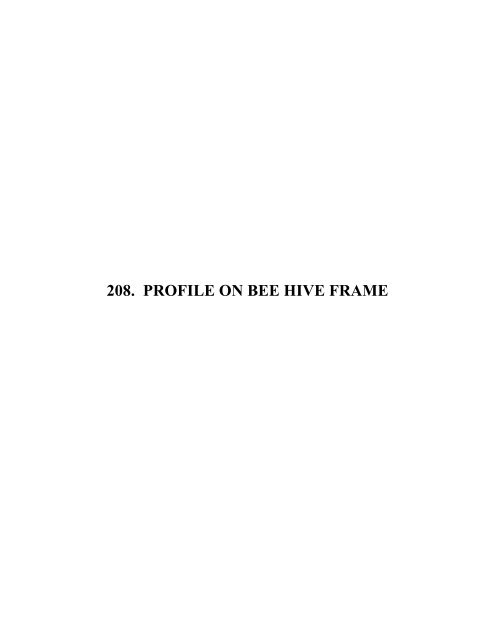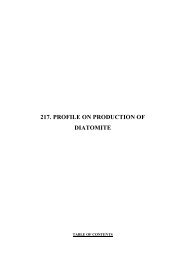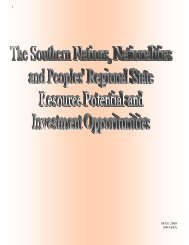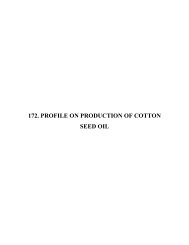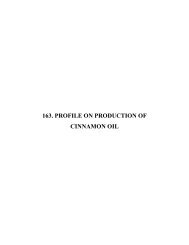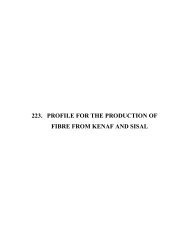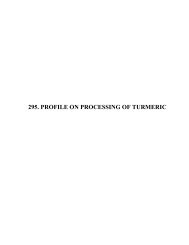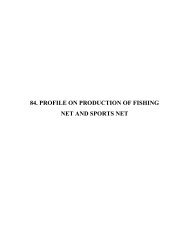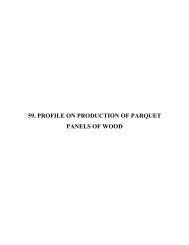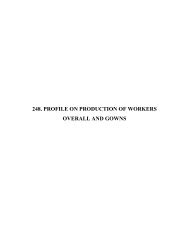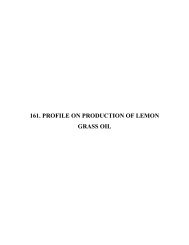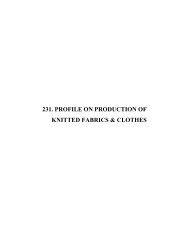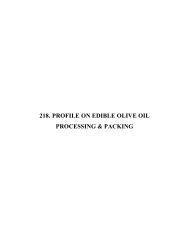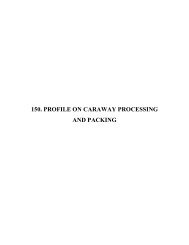PROFILE ON BEE HIVE FRAME
PROFILE ON BEE HIVE FRAME
PROFILE ON BEE HIVE FRAME
Create successful ePaper yourself
Turn your PDF publications into a flip-book with our unique Google optimized e-Paper software.
208. <strong>PROFILE</strong> <strong>ON</strong> <strong>BEE</strong> <strong>HIVE</strong> <strong>FRAME</strong>
208-2TABLE OF C<strong>ON</strong>TENTSPAGEI. SUMMARY 208-3II. PRODUCT DESCRIPTI<strong>ON</strong> & APPLICATI<strong>ON</strong> 208-3III. MARKET STUDY AND PLANT CAPACITY 208-4A. MARKET STUDY 208-4B. PLANT CAPACITY & PRODUCTI<strong>ON</strong> PROGRAMME 208-6IV. RAW MATERIALS AND INPUTS 208-7A. RAW & AUXILIARY MATERIALS 208-7B. UTILITIES 208-7V. TECHNOLOGY & ENGINEERING 208-8A. TECHNOLOGY 208-8B. ENGINEERING 208-8VI. MANPOWER & TRAINING REQUIREMENT 208-9A. MANPOWER REQUIREMENT 208-9B. TRAINING REQUIREMENT 208-10VII. FINANCIAL ANALYSIS 208-10A. TOTAL INITIAL INVESTMENT COST 208-11B. PRODUCTI<strong>ON</strong> COST 208-12C. FINANCIAL EVALUATI<strong>ON</strong> 208-13D. EC<strong>ON</strong>OMIC BENEFITS 208-14
I. SUMMARY208-3This profile envisages the establishment of a plant for the production of bee hive framewith a capacity of 2,000 pieces per annum.The present demand for the proposed product is estimated at 42,420 pieces per annum.The demand is expected to reach at 76,396 pieces by the year 2020.The plant will create employment opportunities for 18persons.The total investment requirement is estimated at about Birr 1.81 million, out of which Birr90,000 is required for plant and machinery.The project is financially viable with an internal rate of return (IRR) of 16 % and a netpresent value (NPV) of Birr 476,820 discounted at 8.5 %.II.PRODUCT DESCRIPTI<strong>ON</strong> AND APPLICATI<strong>ON</strong>Modern bee keeping equipment comprises of beehives, Bee smoker, Queen Extractor, Waxpress Honey extractor and protective clothing, etc. In this study only moveable frame ofLangs froth hive is considered, as this is the most demanded by modern bee deeper toreplace the old traditional beehives.In moveable-frame hives, the bees construct comb in frames which contain an embossedsheet of beeswax foundation which serves as a “pattern” to ensure straight, centered combsin the frames. These hives are constructed so that there is a bee space between the framesthemselves and between the frames and the box holding them.Communicating hive boxes can be stacked one above another, and that the queen can beconfined to the lowest chamber (brood), by means of a queen extruder. In this way, theupper chambers (called supers) can be reached only by the workers and therefore containonly honeycomb. This made hive inspection and many other management practice
208- 4possible. Commercial hives operating on the Langsfroth pattern may contain 10 to 13frames.III.MARKET STUDY AND PLANT CAPACITYA. MARKET STUDY1. Past Supply and Present DemandBeehive frame is used for bee keeping in a safe way and with better handling. Currently,the demand for the product is met through domestic production. The Southern Nations andNationalities Region (SNNR) is one of the most know potential areas for bee keeping inthe country. According to the resource potential study, the region has a total of 1,114,303beehives, of which 1,060,512 are traditional, 50,980 are modern and 2,811 areintermediate. The annual honey output of these hives is about 9,384 tons, of which about72% is obtained from traditional hives.On the average, traditional, intermediate and modern hives respectively yield about 5 kg,15 kg and 25 kg of honey annually. This marked difference in output is likely to inducefarmers to replace traditional beehives with modern and improved ones. In determiningthe present demand for beehive frames, following the study of apiculture equipmentconducted for the region, the existing traditional beehives are conservatively assumed to bereplaced with modern ones in the coming 25 years. The present effective demand forbeehive frames is thus estimated at 42,420 pieces per annum (i.e. 4% of the existingtraditional beehives).2. Demand ProjectionThe method used to determine the present effective demand is applied in projecting thedemand for beehive frame. The projected demand for the product is shown in Table 3.1.
208-5Table 3.1PROJECTED DEMAND FOR <strong>BEE</strong><strong>HIVE</strong> <strong>FRAME</strong> (PIECES)Year Projected Demand2007 424202008 441172009 458822010 477172011 496262012 516112013 536752014 558222015 580552016 603772017 627922018 653042019 679162020 706332021 734582022 763963. Pricing and DistributionAccording to knowledgeable source, the price of beehive frame is about Birr 375 per piece.This price is adopted for the product of the envisaged plant.The product can get its market outlet through the existing agricultural inputs andequipment distributing enterprises throughout the region. Close collaboration with theRegion’s Bureau of Agriculture is imperative to promote the product.
208-6B. PLANT CAPACITY AND PRODUCTI<strong>ON</strong> PROGRAMME1. Plant CapacityThe annual production capacity of beehives production project is 2,000 pieces, based on300 working days and a single shift of 8 hours per day. This capacity can be increased byincreasing the number of working hours per day.2. Production ProgrammeTable 3.2 shows the production programme of the envisaged project. At the initial stage ofthe production period, the plant requires some years to penetrate into the market.Therefore, in the first and second year of production, the capacity utilization rate will be70% and 85%, respectively. In third year and thereafter, full capacity production shall beattained.Table 3.2PRODUCTI<strong>ON</strong> PROGRAMMESr. ProductProduction YearNo.2007 2008 2009-20161. Beehives (pcs) 1400 1700 20002 Capacity Utilization 70 85 100(%)IV.RAW MATERIALS AND INPUTSA. RAW MATERIALSRaw materials of the project are seasoned wood (Timber), glue, nails and others. Thewood should be termite proof, resistant to the rotting effect of the sun and rain, warp-proofand non-bee repellent. The total annual cost of raw materials is estimated at Birr
208- 7191,440.00. Table 4.1 indicates the annual requirement of raw materials of the proposedproject.Table 4.1RAW MATERIALS REQUIREMENT AND COST(AT FULL CAPATIY)Sr.Raw MaterialUnit ofQty.Cost (‘000 Birr)No.Measure1. Seasoned wood/Timber m 3 120 180.8402. Glue Kg 200 43. Nails Kg 300 34. Others LS 3.6Total 191.44B. UTILITIESElectricity and water are the principal utilities of the project. The annual utilitiesrequirement and cost are indicated in Table 4.2.Table 4.2UTILITIES REQUIREMENT AND COSTSr.UtilityUnit ofQty.Cost (‘000 BIRR)No.Measure1 Electricity kWh 20,000 9.4722 Water m 3 600 6Total 15.472
208-8V. TECHNOLOGY AND ENGINEERINGA. TECHNOLOGY1. Production ProcessSeasoned wood/Timber is cut into sizes to produce the different components of thebeehives. The width of the wood must be exactly 32mm. The tropical honeybee builds acomb which has a thickness of 25mm. The comb is usually attached to the center of thetop-bar. A space of 3.5mm is, thus, left at either side of the comb. When two or more topbarsfixed with combs are placed side by side, the inner space becomes 7 mm. This space,vital to the bees, is usually called as the “bee space”. These bee spaces are also foundbetween the combs and the hive body. They serve the bees as path in which they can movefreely, such intricate construction demands relatively good quality wood and expertise incarpentry.2. Source of TechnologySelam Technical and vocational collegeTel:011 646 2942Web Page: WWW.selamethiopia.orgAddis AbabaEthiopiaB. ENGINEERING1. Machinery and EquipmentThe list of machinery and equipment is indicated in Table 5.1. The total cost of machineryis estimated at Birr 90,000. The plant needs vehicles (one pick-up) for transportation offinished product and for office activities. The total cost of the vehicles is estimated at Birr320,000.
208-9Table 5.1LIST OF MACHINERY AND EQUIPMENT REQUIREDSr. No. Raw Material Qty.1. Circular saw 12. Thickness planner 13. Drilling machine 24. Bench grinder 15. Set of carpentry tools 26. Set of c-clamps 37. Set of parallel clamps 38. Work bench 42. Land, Building and Civil worksThe plant requires a total of 1000m 2 area of land out of which 500 m 2 is built-up areawhich includes manufacturing area, raw material stock area, offices etc. Assumingconstruction rate of Birr 1500 per m 2 , the total cost of construction is estimated to be Birr1.5 million. The total cost, for a period of 80 years with cost of Birr 1 per m 2 , is estimatedat Birr 1000. The total investment cost for land, building and civil works is estimated atBirr 1,501,000.3. Proposed LocationAccording to the resource potential study of the region, the raw material is identified inWoredas like Masha and Konta special woreda. Based on the availability of raw materialinfrastructure, utility and market out let Masha town of Masha woreda is selected andrecommended to be the location of the envisaged plant.
VI.208- 10MANPOWER AND TRAINING REQUIREMENTA. MANPOWER REQUIREMENTThe manpower requirement of the envisaged project is 18 persons. The list of manpower isindicated in Table 6.1. The total annual labour cost including fringe benefits is estimatedat Birr 148,500.Table 6.1MANPOWER REQUIREMENT AND LABOUR COSTSr.No.Description Req.No.MonthlySalary (Birr)Annual Salary(Birr)1. General Manager 1 2,000 24,0002. Secretary/cashier 1 700 8,4003. Production Head 1 1,200 14,4004. Operators 4 2,400 28,8005. Fitters 4 1,600 19,2006. Labourers 5 1,500 18,0007. Guard 2 500 6,000Sub-Total 18 9,900 118,800Benefits (25% BS) 2,475 29,700Grand Total 12,375 148,500B. TRAINING REQUIREMENTCurrently, government, private and other institutions are training several students on woodwork. In addition, experienced operators and fitters can be assigned for the job. Therefore,the is no need of training arrangement for the envisaged project.
208- 11VII. FINANCIAL ANALYSISThe financial analysis of theprevious chapters and the following assumptions:-bee hives frame project is based on the data presented in theConstruction period1 yearSource of finance30 % equity70 % loanTax holidays3 yearsBank interest 8%Discount cash flow 8.5%Accounts receivable30 daysRaw material local10 daysWork in progressFinished productsCash in handAccounts payable2 days30 days5 days30 daysA. TOTAL INITIAL INVESTMENT COSTThe total investment cost of the project including working capital is estimated at Birr 1.81million, of which 23 per cent will be required in foreign currency.The major breakdown of the total initial investment cost is shown in Table 7.1.
208- 12Table 7.1INITIAL INVESTMENT COSTSr.Total CostNo. Cost Items (‘000 Birr)1 Land lease value 802 Building and Civil Work 1,500.003 Plant Machinery and Equipment 90.004 Office Furniture and Equipment 255 Vehicle 06 Pre-production Expenditure* 757 Working Capital 40.74Total Investment cost 1,810.7Foreign Share 23* N.B Pre-production expenditure includes interest during construction ( Birr 133.04thousand ) and Birr 150 thousand costs of registration, licensing and formation of thecompany including legal fees, commissioning expenses, etc.B. PRODUCTI<strong>ON</strong> COSTThe annual production cost at full operation capacity is estimated at Birr 599,800 (seeTable 7.2). The material and utility cost accounts for 34.5 per cent, while repair andmaintenance take 4.17 per cent of the production cost.
208- 13Table 7.2ANNUAL PRODUCTI<strong>ON</strong> COST AT FULL CAPACITY ('000 BIRR)Items Cost %Raw Material and Inputs191.44 31.92Utilities15.47 2.58Maintenance and repair25 4.17Labour direct71.28 11.88Factory overheads23.76 3.96Administration Costs47.52 7.92Total Operating Costs374.47 62.43Depreciation101.5 16.92Cost of Finance123.83 20.65Total Production Cost 599.80 100C. FINANCIAL EVALUATI<strong>ON</strong>1. ProfitabilityAccording to the projected income statement, the project will start generating profit in thefirst year of operation. Important ratios such as profit to total sales, net profit to equity(Return on equity) and net profit plus interest on total investment (return on totalinvestment) show an increasing trend during the life-time of the project.The income statement and the other indicators of profitability show that the project isviable.
208- 142. Break-even AnalysisThe break-even point of the project including cost of finance when it starts to operate atfull capacity (year ) is estimated by using income statement projection.BE = Fixed Cost = 27 %Sales – Variable Cost3. Payback PeriodThe investment cost and income statement projection are used to project the pay-backperiod. The project’s initial investment will be fully recovered within 6 years.4. Internal Rate of Return and Net Present ValueBased on the cash flow statement, the calculated IRR of the project is 16 % and the netpresent value at 8.5 % discount rate is Birr 478,820.D. EC<strong>ON</strong>OMIC BENEFITSThe project can create employment for 18 persons. In addition to supply of the domesticneeds, the project will generate Birr 486,510 in terms of tax revenue. The establishmentof such factory will have a foreign exchange saving effect to the country by substitutingthe current imports.


